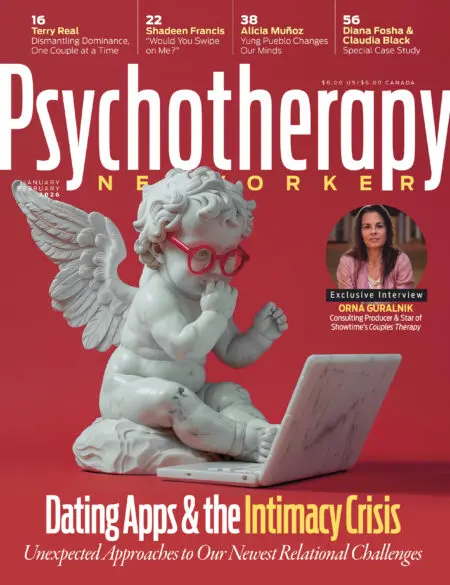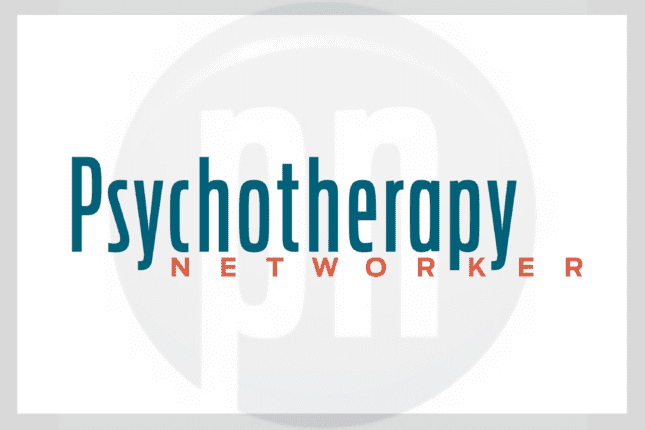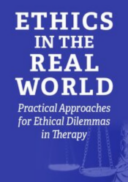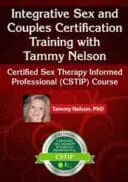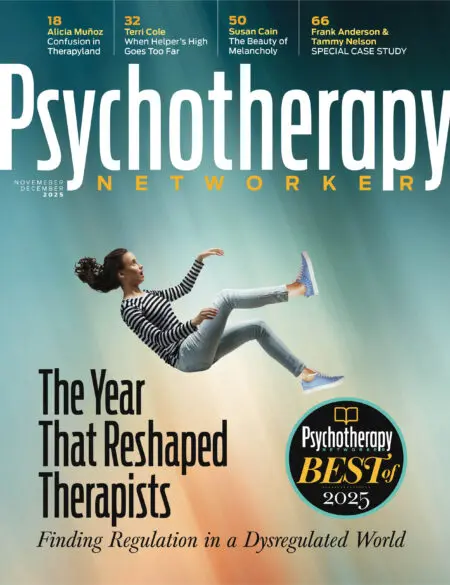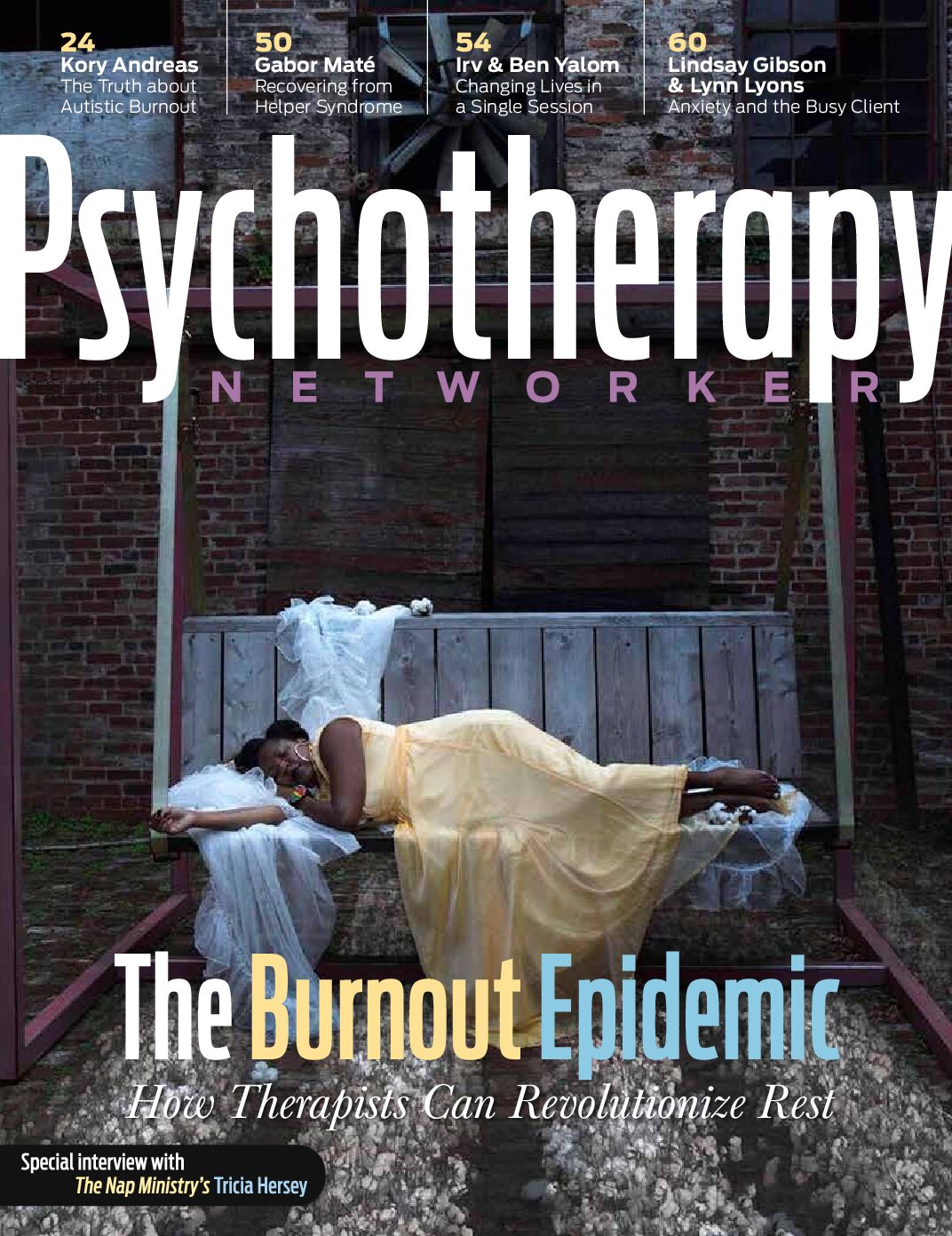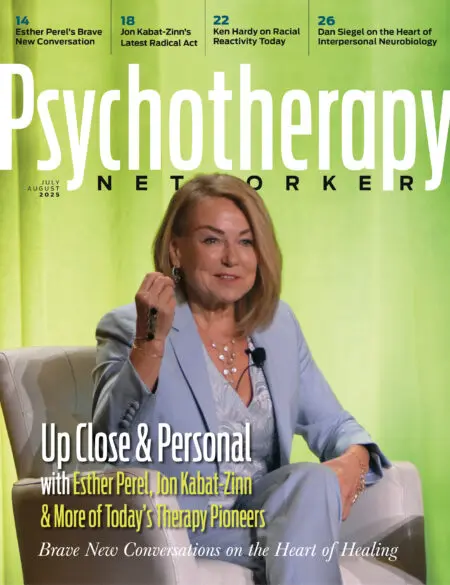Nearly 90 years since F. Scott Fitzgerald wrote his classic The Great Gatsby,the new film version has given renewed currency to the novel’s famous final line: “So we beat on, boats against the current, borne back ceaselessly into the past.” What’s afforded this passage such staying power is not only its haunting poetry, but the worldview it expresses—however hard we may try to reinvent ourselves, we’re doomed to remain captives of our pasts. Another celebrated author, William Faulkner, put it this way: “The past is never dead. It’s not even past.” Eugene O’Neill penned these words: “There is no present or future, only the past, happening over and over again, now.”
Throughout its history, many in the field of psychotherapy have been similarly pessimistic about people’s ability to liberate themselves from the past. It can even be argued that most modern cognitive-behavioral approaches are based on the assumption that, at best, therapists can only incrementally create new emotional and behavioral habits that work around—but don’t actually transform—the deep-seated emotional programming that causes clients’ most visceral distress. This way of thinking, however, doesn’t reflect our current understanding of how memory functions, nor do the therapeutic approaches that aim simply to manage or circumvent entrenched emotions, beliefs, and behaviors rooted in painful past experiences.
While most neuroscientists once believed that implicit memories, avoidance reactions, and rigid schemas were locked permanently in the brain’s synaptic pathways, recent brain research shows that, under certain conditions and within a brief timeframe, we can not only unlock these neural pathways, but actually erase them and substitute new learning. What psychotherapy has added to the discoveries of the research lab is a range of experiential methods that make it possible for therapists to help clients move on from the past, allowing it to release its terrible grip on the present.
This type of swift, deep, enduring change—popularly known as the clinical breakthrough—has occurred in a wide range of relatively new “deep change” approaches, all of which have a strong experiential component: Eye Movement Desensitization and Reprocessing, Somatic Experiencing, Emotion-Focused Couples Therapy, Coherence Therapy, Internal Family Systems Therapy, Hakomi, and Neuro-Linguistic Programming, to name just a few. Of course, therapists have used all sorts of metaphors and theoretical concepts to describe breakthroughs since the emergence of our field. The difference today is that through understanding what’s happening in the brain, we can unshroud the mystery of what’s happening in the consulting room and make such breakthroughs happen far more regularly in our offices.
Locked and Unlocked Emotional Learnings
Therapeutic breakthroughs don’t come easily for good reason. As relatively puny, hairless, vulnerable creatures in a world of stronger, more aggressive predators, we’ve evolved to favor false positives—reacting to learned signs of danger even in the absence of actual danger—over false negatives—ignoring potential threats. Since before our oldest hominid ancestors walked the earth, our nervous systems were biologically wired to keep fully alive the memory circuits of learned threat and danger for the duration of our lives, guaranteeing that we won’t ignore cues to potentially perilous situations that could threaten our survival. From this perspective, the staying power of intense, distressing emotional arousal isn’t a sign of dysfunction—quite the opposite. The fact that raw feelings of fear and rage can be retriggered by implicit cues learned in the past for alerting us to threats, even if the threat is no longer present, indicates that the emotional brain is functioning properly.
The hidden workings of emotional memory are greatly clarified by recognizing that memories of events are different from the learnings based on those events. Each of these memory types is stored in its own separate network in the brain. Consider perfectionism as an example of an emotional learning that therapists frequently encounter. Some clients describe clear memories of original experiences in which being imperfect on their part incurred intense shaming or rejection, but they have no awareness of the resulting implicit learning that has since ruled their responses in life—that it’s urgent to be perfect to avoid such suffering. In contrast, other clients are aware of their learned expectation that imperfection is too dangerous to risk, but even when that expectation is triggered, they have no memory of the original life experiences in which that learning formed.
This example shows us that the original, concrete experiences and the learning formed from those experiences are the stuff of two different and separate kinds of memory. The first is episodic memory, or the memory of events that makes up our autobiographical narratives. The second is emotional implicit memory, or nonverbal memory of learned models of how the world functions. Obviously, the cause of the perfectionism is the existence of the emotional learning—the core belief that any imperfection brings rejection so I’ve got to be perfect—and not the episodic memory of original events. For this reason, emotional learnings are the target for the erasure process using new neuroscience. Memory of events is unaffected by that erasure. In other words, after erasure, clients remember what happened in their lives, but become free of their learning-driven emotional reactions.
Even highly competent, mature people who are rational in most areas of life can be suddenly undone when a current circumstance—often perfectly innocuous in itself—triggers an ultradurable emotional learning from the past that’s still tightly enmeshed in their neural wiring. Once the implicit memory is triggered, they’re seized by an emotional state that has a life all its own, with no cognitive awareness of why such a reaction is happening. It could be self-criticism or volcanic rage, numbness or raw panic, underachieving or inconsolable sorrow. Regardless, one’s calm, cognitively evolved state of mind is no match for such a flare-up from the emotional implicit memory system.
It should be obvious, then, why it’s so hard to triumph over old conditioning. In a very real way, we’re going up against nature. Since 19th-century Russian psychologist Ivan Pavlov’s day, even lab studies of the extinction of implicit learnings never achieved erasure, only temporary suppression. It’s no wonder that, until recently, brain researchers believed that the main problem in overcoming old conditioning was that the brain lacked any mechanism for actually erasing negative emotional learnings. The neural circuits of such learnings were known to be held together by ultradurable synapses that were believed to be immutable for the lifetime of the individual, whether animal or human.
Nature, however, turns out to be more ingenious than that. The brain does come equipped with a key to those locked synapses—and we have the resilience to become radically free of our early emotional learnings. This key became evident in 1997, when several labs began publishing reports of a brain process that hadn’t been recognized before. This process turns off a learned emotional response at its roots, not by merely suppressing it—as in a behavioral-extinction procedure—but by actually unlocking the neural connections holding it in place and then erasing it within the nervous system. Brain researchers named this process memory reconsolidation, and went on to demonstrate how it works in nematodes, snails, sea slugs, fish, crabs, honeybees, chicks, mice, rats, and humans. Remarkably, what the brain requires to unlock and erase a particular learning follows the same three-step process in all those species: reactivating the emotional response, unlocking the synapses maintaining it, and then creating new learning that unlearns, rewrites, and replaces the unlocked target learning.
What induces the brain to use its built-in key to unlock synapses in this process? The answer was discovered in 2004 by researchers who experimented with, of all things, a group of crabs, whose clearly visible fear responses to predators made them superbly suitable subjects. Héctor Maldonado’s lab in Argentina placed crabs in a test area into which the moving image of a predator was introduced repeatedly. Needless to say, this seemingly near-death experience conditioned an extreme fear response in the crabs. Then one subgroup was placed in the test area one at a time, but the predator image wasn’t introduced, and each crab in this group was simply returned to its safe cage. Crabs in another subgroup were placed back in the test area, but saw the predator coming as usual. Put another way, while one subgroup of crabs simply experienced the familiar “bad” event in the test area, the other group experienced a counterevent that created a sharp, powerful mismatch between learned expectations (“This is where the predator shows up!”) and reality (“Hey, the predator didn’t show up!”).
Previous researchers thought reactivation of emotional learning alone unlocked a learned schema. But Maldonado’s breakthrough with his crab test showed that an additional experience was required to loosen the hold of the fearful schema: a vivid contradiction of the reactivated learned pattern about how the world functions—what researchers call a mismatch experience or a prediction error experience. This contradictory experience, coming while the initial fearful learning was still intensely felt, quickly made the normally robust neural circuits of the target learning become labile and fragile. Then, through an ingenious procedure borrowed from earlier studies—use of a chemical agent that permanently shuts off labile, unlocked synapses but doesn’t affect locked ones—Maldonado and colleagues proved that this prediction error was the key to the measurable erasure of the conditioned fear memory: only crabs that experienced the mismatch no longer responded fearfully in the test chamber.
As this experiment showed, emotional learning circuits unlock and become erasable only when a vivid new experience mismatches what a reactivated emotional learning leads an animal or person to expect. However, once a neural circuit has been unlocked, if nothing is done to erase and overwrite it during the next few hours, the synapses automatically relock—or reconsolidate—and the circuit restabilizes, preserving the original learning. The animal or person is then back at square one—still just as likely to be triggered by a stimulus reminiscent of the original terrifying event.
For the field of psychotherapy, the enormous relevance of later research on the neuroscience of memory reconsolidation is that it’s shown conclusively that using experiential methods to achieve erasure and transformation of the brain’s neural circuits is just as effective as dousing it with chemicals, as was done with Maldonado’s crabs. In fact, in controlled studies with human subjects, experiential methods have successfully erased learned fears, heroin cravings, and other types of emotional learning.
In the study of heroin craving, published in the research journal Science in 2012, the reconsolidation process was carried out with heroin addicts who’d been using the drug for more than 10 years before entering an inpatient detox and rehabilitation program, where the study was conducted. The team of Chinese and American neuroscientists hoped to learn how to use memory reconsolidation to eliminate the almost irresistible learned craving that flares up in addicts when they see drug paraphernalia and other cues that evoke their intense attraction to heroin use and its surroundings.
In the first step of the experiment, the researchers reactivated the targeted learning—that being reminded of getting high leads to the expectation of getting high—of 22 participants. They achieved this reactivation by showing them a five-minute video of scenes of people smoking and injecting heroin. Those images revivified learned expectations of going to places where heroin can be bought, scoring a hit, and shooting up or smoking the drug. This rearoused feelings of heroin craving, and participants rated the strength of their craving using a 0-to-10 scale.
Once the drug use expectations and cravings were retriggered, the participants immediately had a mismatch experience—the second step needed to induce the reconsolidation process. In sharp contrast to the retriggered learning’s expectation of now seeking out and using heroin, the participants experienced being ensconced in the rehab center, where they felt taken care of by helpful, caring staff—and where they knew they would not get to score a fix of heroin. All these features of the actual situation were a strong mismatch of the retriggered expectations of heroin use, so the neural circuits of each addict’s learned expectations unlocked. Fortunately for the clinical use of reconsolidation, the mismatch experience required by the brain to unlock synapses doesn’t have to be as emotionally intense as the target learning. It only has to be a clear, unmistakable departure from what the retriggered learning expects to happen next or expects to be true about the world.
After 10 minutes of that mismatch experience, new learning began, which is the third step of the reconsolidation process. It consisted of one hour of more contact with heroin-related scenes, as well as actually handling heroin-related objects, including simulated heroin. While these activities reactivated participants’ heroin craving, it was now juxtaposed in their minds with the certainty that no seeking or using heroin would follow and that they’d continue to be helped and taken care of, ensuring their comfort and well-being without getting high. This new learning experience could be put into words like this: “After seeing and touching things that remind me of heroin, nothing that involves my using it will happen afterward. I won’t be using, and I’ll be fine. I’m okay without a fix of heroin, even after feeling a craving for it.” Of course, a comforting, safe environment is the norm in detox, but in this case, that norm was used within the steps of the reconsolidation process—meaning that craving and expecting heroin were strongly evoked before reencountering the comfort and safety of the environment.
Researchers then measured the effects of this procedure one day, one month, and six months later and found a persistent, dramatic drop in heroin craving among study participants in response to heroin-related cues. Averaged across participants, heroin cravings decreased by 75 percent, according to their subjective ratings, and the shift was corroborated by measurements of a precipitous drop in blood-pressure increases in response to heroin-related cues. A control group’s craving dropped by only 25 percent.
This study is widely praised for demonstrating that reconsolidation works on the relatively complex learnings maintaining an addict’s craving, though it wasn’t meant to be real therapy and didn’t address whether the results held after participants left the rehab center. It’s fascinating that the new learning, described above, resulted in not just a toleration of feeling heroin craving, but a huge reduction of that craving, which seems to mean the craving was generated by the learnings that were dissolved through memory reconsolidation.
Of course, while these and many other highly controlled studies show that the three-step sequence accounts for the brain’s erasure of emotional learnings, the uncontrolled complexity that therapists contend with in their sessions is another domain entirely. Why should anyone think that erasing simple classical conditioning in crabs or the cravings of addicts securely enfolded within a hospital program will carry over into true therapy? The answer lies in the work of two of the authors (Ecker and Hulley), who, in the early 1990s, closely scrutinized large numbers of lasting therapeutic breakthroughs and found they were brought about by the same sequence of experiences later identified in reconsolidation research. The process was described in their 1995 book Depth Oriented Brief Therapy.
We’ve now had 20 years of learning how to facilitate the erasure process in therapy and training therapists to use it. Out of this exploration has come a large body of clinical observations and case studies showing that the needed sequence can indeed be guided systematically in therapy, yielding the same markers of profound change that researchers regard as the distinctive signature of erasure. The clinical examples that follow show the emotional depth and versatility of the therapeutic reconsolidation process, as well as the freedom of style and technique available to therapists within the three-step blueprint.
Reconsolidation in Therapy
Carol was in her mid-thirties and had an 11-year-old daughter. Despite her emotional closeness with her husband, she had an aversion to sex with him, which baffled and saddened her. In therapy, one of our female associates initiated guided discovery work to find out why, in Carol’s world of nonconscious learnings, it was important to avoid sex with her husband. Soon, in a quiet voice, with her legs crossed and her head in her hands, Carol recalled that when she was 15 years old, her mother had walked into the bathroom, found her masturbating, and become overjoyed. Her mother, who was flagrantly open about her own erotic behavior, then deeply mortified Carol by telling her father and several family friends about this “beautiful news.”
In revisiting this episode, Carol became aware of the unconscious emotional learning, or implicit schema, that resulted from that experience: sexuality has no boundaries within a family. What that meant to her emotional brain in her present family life was that enjoying sex with her husband would make her similar to her mother and mortify her own daughter through a violation of sexual boundaries. That expectation had been making avoidance of sex urgently necessary.
Carol’s implicit schema certainly had formed as a result of an insecure attachment bond with her mother, but it couldn’t be decisively contradicted and disconfirmed through a relationship with a trusted female therapist, as strict attachment theory would dictate. Instead, our colleague approached emotional contradiction through another route. When Carol left the session, she carried an index card on which the therapist had written her new, now explicit awareness: “I hate to admit it, but experiencing sexual pleasure with my husband makes me more like my mother. So, even though it’s hurting my marriage, I’ll continue to avoid sexual contact, because it’s better to sacrifice pleasure and intimacy than to risk doing to my daughter what my mother did to me.” Carol was now facing and feeling the previously unconscious emotional schema that was driving her dread of being sexual. It’s this emotional learning or schema that would now be the target for erasure.
Her homework was simply to read this card every day. Doing this would integrate her new awareness of her problematic learning into everyday consciousness, laying the foundation for a mismatch experience. In her next session, she told her therapist that something had shifted, because the sentences on the card—which had been deadly serious to her before—had begun to seem “almost silly.” With delight in her self-discovery, she said she’d realized that her sexuality was her own, not her mother’s. That lucid realization was the contradiction of the target learning, and it created the mismatch needed for unlocking synapses.
Each time Carol had read her card, she’d encountered that contradiction and juxtaposition, and then over the next several minutes, this intriguing disconfirmation drew her attention repeatedly. This repetition brought about the new learning that rewrote and replaced her schema about family sexuality, making the schema feel no longer emotionally real. We’ve guided this process and seen it unfold in sessions hundreds of times, but often it happens with a life of its own between sessions, as it did for Carol.
She called this shift a “freeing experience” and said that it had already improved her relationship with her husband. Her description of “almost silly” and her positive readiness to engage sexually with her husband were clear markers that a nullification of the past problematic learning had taken place in her brain.
The Juxtaposition Experience
The moment of viscerally felt contradiction is what we call the juxtaposition experience in Coherence Therapy. Regina’s case illustrates yet another way to reach that pivotal moment. A married mother of three and full-time professional, Regina had frequent bouts of panic during or right after social interactions, even with people she genuinely liked and knew well. She worried this meant she was “crazy.”
Discovery work with her revealed that her anxiety began with a perception that someone had become even mildly displeased with her. That perception triggered an implicit expectation that a brutal rejection would follow.
Probing for attachment roots, her therapist asked gently, “When you were little, was it scary for you when someone became displeased?”
Regina nodded and became teary while describing her mother’s sudden harshness and the way she’d yell at her, for example, for “making a mess” when she’d find Regina on the floor, drawing with her crayons on a piece of paper. Her mother often negatively compared her to the neighbor’s daughter, verbally abused her by calling her “a piece of crap,” and made overt threats of abandonment. In addition, these denigrations sometimes took place in front of visiting relatives, which was deeply humiliating and terrifying for Regina. In essence, she lived in perpetual fear of “making my mom start to hate me again.”
When her therapist asked Regina to compare a recent instance of perceiving a negative social response from someone with an old memory of seeing Mom become displeased, she said the experiences felt the same. At this point, the therapist guided Regina to visualize her mother and become explicitly aware of the implicit terms of attachment she’d learned from her—the specific rules of the conditionality of love. The therapist went on to help Regina verbalize her emotional learning in the following way: “The slightest imperfection makes me completely disgusting and unlovable, so Mom wants to get rid of me and have some other girl instead, and I’m really scared that she might actually get rid of me. I’m acceptable and lovable only if I do everything perfectly. Everyone I ever know will reject me whenever some imperfection becomes visible, and I’m always dreading that and feel panic each time I think it’s happening.”
Regina had clearly generalized her mother’s terms of attachment to all other people, which drove her anxiety and panic, so her specific expectation that “everyone I know will reject me whenever some imperfection becomes visible” became the target for dissolution through the erasure sequence of memory reconsolidation. The next step was to find a contradictory felt experience that was vivid and powerful enough to disconfirm and dissolve that target learning. To pursue that, the therapist asked, “Do you have a grandparent, an aunt, or uncle who’s special to you?”
Regina nodded. Her uncle Theo was extremely special, she said. The therapist then guided her to picture him by saying, “Feel the warmth of your love for him and just notice where in your body you feel it.” After a while, the therapist continued, “Go ahead and say to him what you believe from Mom. Try telling him, ‘You love me only because I seem perfect, and you’d stop loving me if I let any of my imperfections show.’”
After internally saying this to him, Regina sat still for a while. “What’s happening now?” the therapist asked softly.
With tears in her eyes, Regina reported, “The look on his face—he was so hurt by it.”
“How do you understand his being so hurt by it?” the therapist asked.
Regina replied, “It’s like it was a deep insult to his love for me, like I’m saying his love is lightweight and superficial, and he knows it isn’t.” Beginning to cry openly, she continued, “He knows he really loves me with all his heart, and imperfections wouldn’t change that. So it’s like I’m totally wasting his love if I think it’s only because I seem perfect.”
There it was—the contradictory living knowledge that others aren’t necessarily the same as Mom. After about 30 seconds of silence in which Regina seemed to be absorbing this new knowing, the therapist mirrored it back to her by saying empathically, “He really loves you, whether or not your imperfections show up.” With a nod, she confirmed the clear emotional truth of this recognition.
The ingredients needed for guiding the erasure sequence of memory reconsolidation were now in hand. The first step was to reactivate the target learning, so the therapist prompted Regina to picture her mother again and said, “What you know about her love is that it quickly disappears and turns into disgust and rejection when any imperfections show up, and you could easily expect that’s how it would be with anyone, yes?”
Regina’s earnest nodding indicated she was viscerally in touch with that emotional knowledge, so the therapist continued on to the second step: evoking the contradictory, mismatching knowledge. “On one side, there’s Mom, and on the other side, there’s Uncle Theo. His love is steady and reliable and unaffected by imperfections, and he just sees and feels how lovable you are and nothing changes that.” Regina listened with eyes closed, seemingly absorbed in the developing juxtaposition experience. The target learning’s synapses were unlocking.
Over the next few minutes, the therapist continued to call Regina’s attention to that juxtaposition—the repetitions that serve as new learning that rewrites the target learning: “Both kinds of love feel so real, but they’re so different. Can you feel both at once? Good. What’s that like for you, seeing so clearly that both kinds of love exist, and that you’re actually experiencing both?”
Guided in this way to apply mindful awareness to the juxtaposition experience, Regina sat silently, thinking and blinking, and then said, “I never thought of it like this before.”
“Yes, it’s very new,” the therapist said, then guided another repetition by asking, “And as you look back and forth at your Mom and Uncle Theo, what happens?”
After another silence, Regina answered, “It’s strange, but my Mom looks smaller.” This was a first marker of a transformational shift in her mental model of her mother. She added, “And it’s like what’s wrong is over there in her, not here in me,” which was another marker of change, indicating the beginning of dissolution.
Knowing that such fundamental shifts often have immediate, challenging ripple effects, the therapist now asked, “Is it entirely comfortable to know that the problem is in Mom and not in you? Or is there something uneasy about that?”
Regina replied, “It feels scary because then I can’t have any control over it. If it’s in me, I have a chance of controlling it. But if the reason she blows up at me is that she’s messed up, then I can’t possibly control it.” Then she added, “But I’m feeling relief, too, because if she’s the problem, then maybe there’s nothing seriously wrong with me after all. And maybe I won’t be rejected forever by anyone who gets to know me.”
Although further work was needed to explore the “scary” loss of the illusion of control, this emergence from a lifetime of self-invalidation into a recognition of her own intactness and worth was a completely unprecedented shift for Regina. The main breakthrough had occurred.
Ready for Unlearning
The cases of Carol and Regina illustrate how different techniques can be used to facilitate the brain’s core process of profound unlearning. That’s why this process can be fulfilled within many different systems of experiential therapy. The particular usefulness of our Coherence Therapy approach is that its steps match those of the reconsolidation process: first, evoke into direct experience the emotional learnings underlying the client’s unwanted patterns. Then find a vivid knowledge or experience that contradicts those learnings. Finally, combine those two into a juxtaposition experience and repeat it several times.
Using Coherence Therapy to dispel a hair-trigger temper was the challenge with Raoul, a 36-year-old carpenter who installed fine maple and oak cabinets in expensive kitchens. He came to his first appointment, despite his considerable bias against therapy, to deal with frequent flare-ups of anger that baffled and demoralized him. In a variety of situations, he found himself bursting with rage, shouting at his wife, his two young children, or his best friend—sometimes even at other tradespeople on a job or the occasional hapless sales clerk. At times, he had to storm out of a room to prevent himself from hitting someone. He wasn’t sure why he kept blowing up and he wondered aloud during his first session whether he needed medication for some sort of “brain glitch.”
The discovery work began by engaging Raoul in looking closely at several recent explosive interactions, and he readily came to a new awareness: his anger flared when he thought that the other person had broken an agreement between them, even if only in some minor way. A few seconds after this recognition, another realization came, revealing why broken agreements were such a hot button. Five years earlier, he’d started a business with another talented carpenter. Together they’d installed Raoul’s treasured tools in a rented cabinet shop and set out to build custom kitchens, agreeing to split the profits down the middle. After a promising start, the partner became disorganized and careless. First, a few tools went missing from the shop. The partner promised to return them as soon as he finished a side project in his garage workshop, but didn’t. Then the partner withdrew some funds from their business bank account. Afterward, he didn’t show up for a time-sensitive remodeling job several mornings in a row, blaming his absences on a family crisis.
One morning, Raoul drove up to the shop and discovered that it had been stripped completely of tools, including a set of fine Japanese wood chisels he’d inherited from his father. The partner was gone, as was all the money remaining in their bank account. In a state of deep shock, anger, and sorrow, Raoul was forced to declare the business bankrupt, let go of a long-treasured dream, and start over as a hired hand for general contractors.
Raoul’s shock at his business partner’s betrayal had engraved rigid emotional responses in the neural pathways and synapses of his brain’s implicit memory networks. Whenever an interpersonal interaction seemed reminiscent of the betrayal, a web of neurocellular pathways would become activated, instantly launching an urgent, self-protective response—anger.
To find out why Raoul’s dominant response was anger—rather than depression or a sense of vulnerability, for example—the therapist engaged in further discovery work using the experiential technique of symptom deprivation. If the cause of Raoul’s anger was in some sense an emotional necessity, then being without the anger would cause discomfort, and deeply exploring that discomfort would put Raoul directly in touch with a hidden problem that he was solving with anger. Guiding him to revisit a situation in which his anger had flared because of a perceived breach of agreement, the therapist said, “See what it feels like if anger doesn’t come. Just notice what you start to experience instead.”
Through several rounds of symptom deprivation, Raoul experienced three distressing dilemmas that he’d been avoiding with anger, and he verbalized them with the therapist’s help:
“Without my anger, I feel powerless and defenseless against being deceived again, so I need my anger.”
“Without my anger, I feel such intense grief and heartbreak over what I’ve lost that I might be swept away by it and unable to function, so I need my anger.”
“Without my anger, I feel he totally got away with it and there’s no accountability or justice in the world. Letting go of my anger would be letting go of my demand for accountability and justice—and that’s totally unacceptable to me.”
Addressing the first response, the therapist asked Raoul to say more about how vulnerable he felt to being deceived again.
“I didn’t see it coming, so how am I going to see it coming next time?” Raoul asked. The therapist responded, “I can understand that sense of vulnerability, but I’m also wondering whether there’s been something in your life that makes it extra uncomfortable to feel vulnerable, so that it’s better to get angry instead. Can we look at that?”
Raoul revealed that in his family of origin, a man who was worthy of respect never felt powerless and defenseless. Men were always supposed to know what to do, be strong for everyone else, and show no fear or pain. “That’s how I grew up. That’s my culture.” Being perceived as falling short in these qualities was shameful and had real consequences, like being excluded from important social circles and networking possibilities.
The therapist then helped Raoul dig deeper, resulting in this statement: “I can’t risk feeling this vulnerability because it’ll make me be seen by everyone as weak. I’ll be stuck forever in shame and excluded forever from things that are important to me.”
The therapist wrote this on an index card and asked Raoul to read the card every day between sessions. In his next session a week later, he reported an inner shift: “I’d look at a neighbor or at friends we were having dinner with, and think, ‘Really? This person would judge and exclude me like that? I don’t think so!’” Raoul was describing juxtaposition experiences that arose in daily life as a natural result of holding the schema consciously.
The therapist asked him to again say aloud the sentence on the card, and now it was flat and void of emotional resonance. His emotional schema had been dissolved. With the old social punishments no longer expected, his sense of vulnerability was greatly reduced, and the need to avoid it was no longer urgent. So his anger was no longer needed and the sentence was obsolete.
The therapist then addressed Raoul’s second statement: “Without my anger, I feel such intense grief and heartbreak over what I’ve lost that I might be swept away by it and unable to function, so I need my anger.”
His expectation of being overwhelmed by his feelings was the target emotional learning here. The best contradictory experience would be seeing for himself that it wasn’t so. To make it safe enough for Raoul to begin to feel his grief directly and realize that it wasn’t overwhelming, the therapist said, “Ungrieved grief causes people all kinds of trouble. Here in my office, with me guiding you, would you be willing to allow a minute or two of feeling just a small degree of the sensation of the heartbreak that you’re carrying around? I can coach you on how to open the valve a little, just for a minute. And then you’ll see that the valve closes, without the overwhelming feelings you’ve been anticipating.”
Raoul was wary but willing to try, so the therapist said, “Say these few words out loud: What I lost really hurts.”
He thought about that for a few seconds, and then said he wanted to change the words to “What was stolen from me really hurts.” Raoul then said those words.
After a few seconds, the therapist asked, “Do you feel anything in your body with that?” Raoul put his hand on his solar plexus and said, “Yes, it feels hot and tight right here.”
“OK,” said the therapist, “let your hand lightly hold or massage that place for a few seconds, and then we’re done with it for now and we’ll focus on other things.”
Gradually, over several sessions, Raoul opened to the full, direct experience of his grief, and each time, he saw that the waves of grief and pain, even the most intense feelings, lasted only a few minutes at most. To ensure that juxtaposition experiences were occurring, at certain points the therapist briefly guided him to connect with his old expectation of being overwhelmed. Toward the end of this process, the therapist asked, “How much is left of thinking you’ll be wiped out by the grief you feel? What percent?”
“Close to zero,” Raoul confirmed. Beyond allowing his grief process to unfold, this approach had transformed his knowledge of his own capacity to feel emotion.
Raoul’s third statement was “Without my anger, I feel he totally got away with it and there’s no accountability or justice in the world. Letting go of my anger would be letting go of my demand for accountability and justice, and that’s totally unacceptable to me.” His business partner had stolen his money, as well as his hopes and dreams, and Raoul was struggling to keep alive his implicit model of the world as being good and just, and relying on his angry demand for accountability to accomplish that. In essence, resorting to anger was his passionate campaign to preserve a sense that there’s good in the world.
The therapist asked Raoul if he felt any connection between this campaign and what he’d previously described about the total honesty and goodness of his family. His childhood, he’d said, was sheltered from bad experiences and scoundrels, leaving him unprepared for such encounters. To help him access that theme emotionally, the therapist said, “To you as a boy, the world of people seemed to be all goodness, and then, at 31, you had a powerful, traumatic encounter with badness. I can imagine that might be challenging to come to terms with. Could we take a look at what’s going on inside about that?”
That question opened the door to a chamber of implicit meanings, and Raoul now recognized that his angry quest for justice was actually his desperate attempt to preserve the innocent, uncompromised world he’d experienced as a boy. With this dilemma in mind, the therapist commented empathetically, “So, for you, the existence of this bad person has the power to nullify all the good that you also know exists.” Raoul’s mismatch detector immediately swung into action on his revealed schema, lighting up his own contradictory knowledge and creating juxtaposition experiences. He soon arrived at a new, more nuanced model of the world. As Raoul put it, the world “contains lots of good and some bad.” He no longer needed to be an angry seeker of justice and accountability. In his last session, he announced that his wife, with great affection and gratitude, had offered the final verdict on his healing journey: “The man I married is finally back!”
—–
Of course, neuroscience has yet to magically transform psychotherapy, making all that was opaque, hidden, and out of control now clear, open, and well regulated. So after years of fascination and even infatuation with brain science, it’s understandable that some therapists have grown a bit disillusioned with the whole subject.
Yet a new wave of neuroscience centered on memory reconsolidation offers us specific knowledge of the steps through which people change their subcortical minds deeply and transformationally, altering their understanding of how the world functions, what their most intimate relationships mean to them, and how to expand their ability to respond flexibly to life’s challenges.
What we’ve observed in our work demonstrates how the discoveries of brain science can help us create liberating breakthroughs for our clients more consistently than was ever thought possible. We may even find that memory reconsolidation is a core process detectable in all therapies that regularly yield transformational change, as our own examinations of published case examples is indicating. While neuroscience may speak in an esoteric, polysyllabic language, it’s offered us a profound new understanding of how to alleviate some of the oldest forms of human suffering. In the future, it will surely tell us a great deal more.
Robin Ticic also contributed to this article. Robin Ticic, B.A., H.P. Psychotherapy (Germany), is the Coherence Psychology Institute’s director of training, a trauma therapist associated with the University of Cologne, and author of How to Connect with Your Child.
Photo © Ocean / Corbis
Bruce Ecker
Bruce Ecker, MA, LMFT, is codirector of the Coherence Psychology Institute, co-originator of Coherence Therapy, and coauthor of Unlocking Emotional Brain and Depth Oriented Brief Therapy.
Laurel Hulley
Laurel Hulley, MA, is the Coherence Psychology Institute’s director of paradigm development, cofounder of the Julia Morgan Middle School for Girls in Oakland, California, and coauthor with Bruce Ecker of the Coherence Therapy Practice Manual & Training Guide.
